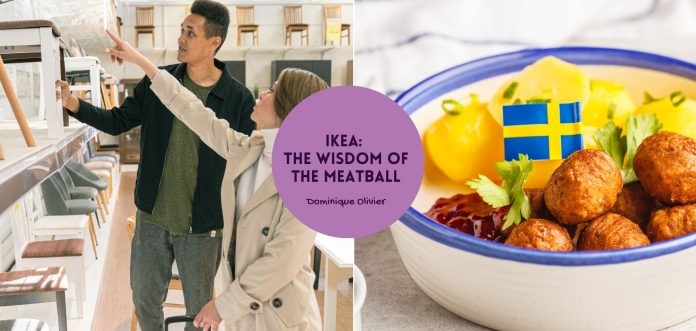The best salesperson in Swedish business IKEA’s history isn’t Sven or Astrid or even Nils – it’s the meatball. Since 1985, the flatpack-furniture giant has sold more than a billion of its trademark Swedish meatballs every year. But how did a furniture company come to rely on meatballs to sell couches? The answer lies in consumer psychology.
Every now and then, you encounter a business that has its feet in two seemingly unrelated yet equally lucrative markets. Yamaha is one of my favourite examples: they are as well-known for their motorcycles as they are for their musical instruments, particularly keyboards. Another is the Virgin Group, famous for its airlines and gyms. 3M manufactures Post-It Notes and specialty dental equipment. What do these pairs have in common with each other? Almost nothing, except for the fact that each pair comes from the same company.
Whenever I encounter a business like this, I can’t help but wonder about the trajectory that led to such an outcome. The business majors in the audience will probably tell me the less interesting story, which is that some of these divergences are the result of company acquisitions or a time in the world when conglomerates were popular – and that’s probably true. But once in a while, you hear a story about a business that turned a sidequest into a fully-fledged source of income, and then some.
Such is the story of IKEA and the meatball.
Enter the labyrinth
We don’t have IKEA in South Africa (yet), but many of us know the name, either from hearing it mentioned in TV shows and films, or from visiting an IKEA store overseas. Now, in a typical furniture store, you’d walk straight to the section you need, find your item, and leave. At IKEA, it’s more of a meander; somewhat of a carefully engineered labyrinth designed to keep you browsing, dreaming, and inevitably leaving with way more than you came for.
At the heart of this strategy is the “one-way layout,” a winding path that guides you through each section of the store in a set order. You don’t just stumble into the living room section; you’re led there after walking through the bedrooms, kitchens, and bathrooms. And while you could technically take one of the sneaky shortcuts sprinkled throughout the store, the layout is designed to keep you on the main route as long as possible. Each section you pass through feels like stepping into a fully realised home, with perfectly styled spaces that make it easy to imagine products in your own life.
The idea is not to buy anything off the floor. Instead, you make a note of the items you want and then collect them, flatpacked, from the warehouse, which is usually found on a level under the showrooms. It comes as no surprise, then, that the average IKEA shopper spends two and a half to three hours in the store every time they visit.
Foreseeing the inevitable, IKEA founder Ingvar Kamprad launched his very first store with an in-store café included. Back then, it was all coffee and cake – just enough to keep shoppers caffeinated for the maze ahead. This brings us to where these little cafés are located – always halfway through the store, never too close to the entrance or the exit. It’s all part of a carefully calculated plan, says Alison Jing Xu, an associate professor of marketing at the University of Minnesota. Xu studies consumer behaviour, particularly how hunger impacts decision-making, and she notes that IKEA has a clever system in place.
The goal isn’t to feed you right away; it’s to let you build up an appetite as you wander through the first half of the showrooms. Once you’re feeling peckish, you’re encouraged to pause for a snack or meal before heading back onto the path. Hunger, Xu explains, focuses the mind on acquiring food, but that desire often spills over into other kinds of shopping. Her research shows that hungry shoppers spend 64% more money than their well-fed counterparts.
But now you’ve eaten in-store, so surely that 64% increase in shopping desire wears off, right? Wrong. The intention behind IKEAs cafeterias was to give shoppers an opportunity to sit, rest and (most importantly) plan how they would decorate their spaces using the things they’d seen up until that point – and it was very effective.
Operation meatball
As IKEA grew, so did its menu, from pastries to Swedish staples like mashed potatoes and sausages. But founder Kamprad wasn’t exactly thrilled with the state of the company’s dining experience. He called the restaurants a “mess,” grumbling that they lacked both quality and a polished image.
By that point, IKEA had around 50 stores worldwide, and Kamprad was worried about a bigger problem: hungry customers leaving the store to eat elsewhere because the cafeterias weren’t alluring enough. Sören Hullberg, an IKEA store manager at the time, had formed a close working relationship with Kamprad, so when Kamprad decided IKEA’s restaurants needed a complete overhaul, he chose Hullberg to lead the effort.
With typical IKEA stores welcoming up to 5,000 customers a day, the menu had to be simple and streamlined to keep operations manageable and costs low. Since the plan was to roll out a standardised menu across different countries, Hullberg and his team sought dishes with universal appeal. That’s when they landed on meatballs. The choice was both cultural and practical. Meatballs are easy to freeze, transport, and prepare quickly in IKEA kitchens – an essential factor given the volume of customers.
The famous IKEA meatball was launched in 1985, and since then, the company has sold over 1.7 billion meatballs every year. For reference: that’s more meatballs annually than their best-selling furniture product, the Billy bookcase. Today, IKEA’s meatball lineup has expanded beyond the classic original to include chicken, salmon, vegetarian, and a newer plant-based option. They’re still served in quintessential IKEA fashion, alongside mashed potatoes, cream sauce, lingonberry jam, and vegetables. For fans who just can’t get enough, frozen versions are available to buy and cook at home.
Like all good things, the meatballs have weathered their share of challenges, including a major recall in 2013 when traces of horse meat were discovered in a European batch. Despite the setback, they remained a core menu item. During the Covid-19 pandemic, when IKEA temporarily closed its restaurants, the brand shared its meatball recipe online, allowing customers to recreate the experience in their own kitchens.
A well-rounded impact
In the four decades since their introduction, IKEA’s meatballs have gone from a cafeteria item to a cultural phenomenon. They’ve achieved global recognition, with countless online recipes, variations, and even dedicated fan communities. In a complete turn about-face, many customers now travel to their nearest IKEA for the meatballs, and look at the furniture on their way out the door.
It makes sense too, if you consider that IKEA deliberately prices their cafeteria items lower than meals at restaurants in their vicinity. For shoppers, this is an opportunity to snag a cheap yet filling meal, albeit in an unconventional setting. As for IKEA… well, even if they make a small loss on the meatballs themselves, they’re still luring thousands of people into having a meal in the middle of their showroom every day.
Ever heard of Costco’s hotdogs? Same WhatsApp group. Those coffee shops at your local WeBuyCars branch suddenly make more sense, don’t they?
About the author: Dominique Olivier

Dominique Olivier is the founder of human.writer, where she uses her love of storytelling and ideation to help brands solve problems.
She is a weekly columnist in Ghost Mail and collaborates with The Finance Ghost on Ghost Mail Weekender, a Sunday publication designed to help you be more interesting.
Dominique can be reached on LinkedIn here.




